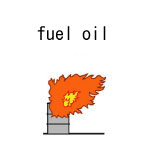| Case Name |
Leakage and fire caused due to a rupture of a heating furnace tube from unbalanced heating at a heating furnace of a fuel oil direct desulfurization unit |
| Pictograph |

|
| Date |
April 26, 1996 |
| Place |
Yonashiro, Okinawa, Japan |
| Location |
Refinery |
| Overview |
The heating furnace had been under unbalanced operation with only the burners at the inlet side used for ten years. In addition, proper load distribution among heating tubes was not carried out, even though the type of crude oil was changed. As a result, part of the heating tube ruptured. Only a partial inspection of coking had been done due to prejudice based on past experience. The temperature sensors were located mainly at the external side where the temperature was normally higher, and seldom at the inlet side where the high temperature caused the accident. Coking developed and a rupture occurred for the reasons above. |
| Incident |
An opening was generated at the inlet side heating tube of the heating furnace in the fuel oil direct desulfurization unit. From the opening, high-temperature and high-pressure feed stock spouted out, and burned explosively. |
| Processing |
Manufacture |
| Individual Process |
Reaction |
| Process Flow |
Fig2.Unit process flow
|
| Chemical Reaction |
Hydro-desulfurization |
| Substance |
Hydrogen, Fig3 |
| Fuel oil |
| Type of Accident |
Rupture, fire |
| Sequence |
On April 17th, 1996. Feed stock was changed to light crude oil.
21:35 on April 26th. A fire broke out.
21:37. A private fire brigade turned out.
22:00. Municipal fire fighters arrived.
02:00 on April 27th. The fire was extinguished. |
| Cause |
As burner heating was concentrated around the heating furnace inlet, coking developed. Temperature partially rose due to reduced heat transfer, which reduced the material's strength. |
| Response |
Fire fighting by a private fire brigade. |
| Countermeasures |
1. Improved operation management.
2. Improved thermometry management.
3. Improved facilities management. |
| Knowledge Comment |
1. Inspection points required for operation management should be comprehensive, and should not be decided based on preconceived ideas.
2. Sensors should be installed at appropriate positions to obtain the desired results. |
| Background |
Among ten burners, only six at the inlet side had been used for ten years, which caused an unbalanced operational load. In addition, appropriate instructions on combustion were not given although the change of the crude oil type changed the operational load distribution of the furnace tubes in the heating furnace. The furnace was designed to keep heat flux below a specific point to prevent coking from developing. Nevertheless, it was assumed that the load was added only at the inlet side to raise skin temperature, and resulted in coking. This is an absolute instruction failure. |
| Incidental Discussion |
As coking usually develops at the outlet side where both process temperature and skin temperature are high, thermometers are mainly placed at the outlet side. In a furnace with a large number of burners, they are arranged so that they are balanced. Are there any other examples in which only burners at the inlet side have been used? |
| Reason for Adding to DB |
Example of fire caused due to an inadequate measuring point and an inspection point of furnace tubes |
| Scenario |
| Primary Scenario
|
Organizational Problems, Poor Management, Poor Operation Management, Poor Value Perception, Poor Safety Awareness, Inadequate Risk Recognition, Ignorance, Insufficient Knowledge, Insuficient Study and Experience, Malicious Act, Rule Violation, Safety Rule Violation, Bad Event, Chemical Phenomenon, Coking, Failure, Large-Scale Damage, Leakage, Secondary Damage, External Damage, Explosion, Loss to Organization, Economic Loss, Direct Monetary Damage 190 million yen
|
|
| Sources |
Fire and Disaster Management Agency, Explosion at fuel oil direct desulfurization unit. Accident examples of dangerous materials, 1996, pp.138-139.
Accident investigation committee. The accident investigation report. (1996)
National dangerous material safety association. Manufacturer and fire. One hundred cases of accidents at dangerous material facilities. p.7(1999)
|
| Physical Damage |
Heat insulation debris was scattered within a radius of 80 meters.
Damage to facilities: FU-301(a heating furnace), piping, an exhaust gas duct, paint on centralized smoke stacks, RE-301A(a heat exchanger) heat-insulating sheet metal were damaged by fire. |
| Financial Cost |
¥ 196 million. (Fire and Disaster Management Agency) |
| Multimedia Files |
Fig3.Chemical formula
|
| Field |
Chemicals and Plants
|
| Author |
WAKAKURA, Masahide (Kanagawa Industrial Technology Research Institute)
TAMURA, Masamitsu (Center for Risk Management and Safety Sciences, Yokohama National University)
|
|